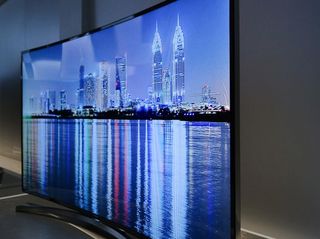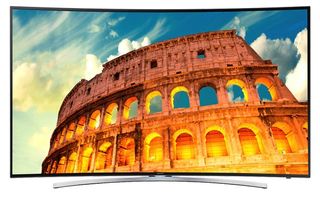Why Curved TVs Will Leave You Flat Broke
Samsung has announced the prices for its new curved-screen HD and 4K TVs, and they aren't cheap. How else could you spend this money on a TV?


To the TV buzzwords "OLED," "4K" and "Ultra HD," you can now add the humble word "curve." All of these options will be available to TV buyers this spring and summer. Manufacturers like Samsung are betting that you'll pay a lot more for a slightly curving TV screen. But there are other ways to spend that money that may get you more entertainment.
"Some of the most valuable works of furniture produced for the art market are based on the curve," said James Zemaitis, new head of Sotheby's 20th Century Design Department, reading from a teleprompter at an event this week unveiling Samsung's new curved HD and 4K UHD TVs. "Curved designs not only catch the eye, but they have a sensory appeal," he added in a reception held at the famously curvy Guggenheim Museum in New York's tony Upper East Side.
MORE: Best TVs 2014
But will curved TVs sell downtown or out in the suburbs? The one factor that keeps most people coming back to buy TVs is size, and the ability to spend less money to get a bigger screen. (Average TV prices nearly halved between 2008 and 2013, according to the Consumer Electronics Association, even though average screen size has gone up a bit.)
The upgrade from a 40-inch to 50-inch TV is worthwhile for families with a big enough TV room. And they can get a 50-inch TV for as little as $500 on Amazon. Even premium-brand Samsung sells a 50-inch, flat HDTV (its new H6400 Smart LED TV) for $1,200. But if you want a slight curve to the screen, the prices start at $2,000 for the new 48-inch H8000 model that Samsung showed today and will start selling in April. That's the price for a 1080p HDTV, not one with the four-times-greater 4K Ultra HD resolution.
Looked at another way, you could spend that same $2,000 not on Samsung's curved, 48-inch model but on the company's flat-screen HDTV measuring 65 inches — close to the upper limit of what people who don't live on Central Park could consider buying.
Flat 4K is Where It's At
Technology moves on, and what seems extravagant one day becomes commonplace and affordable a few years later. If the curved screen does have the appeal that Samsung and Sotheby's believe it does, the curvy TVs may be the technology of the future.
But there's another TV technology of the future: 4K or Ultra HD TVs. Samsung's entry-level model the 50-inch HU8550 (flat, not curved) sells for $2,500 — a bit more than the curved HDTV, but with a lot more capabilities for now and the future. Samsung is offering four lines of TVs that are both curved and 4K, but the curve once again adds a premium. The entry-level curved model is Samsung's $4,000 U9000 55-inch TV.
MORE: What Is 4K TV?
Alternately called "4K" and "Ultra HD," these sets have four times the resolution of 1080p HDTVs, displaying images that are frighteningly close to real life. Of course, that's for the limited amount of true 4K content now available. Most of that is nature, documentary-style footage on YouTube.
But later this year, Netflix will begin streaming 4K versions of its original shows. And Samsung announced today that it is working not only with Netflix but also with Amazon and on-demand streaming service M-GO on 4K content, though the TV maker didn't provide details. Samsung also offers a smattering of 4K content, with the promise of more via download, on its $300 UHD Video Pack, a one-terabyte hard drive that works with the company's TVs. (Sony has a similar, $700 system that offers more content, or Sony TVs)
It's not certain what the ultimate system or systems for delivering 4K content will be, and future 4K may require technologies that aren't yet deployed. But Samsung has thought of that. It will soon sell its $400 UHD Evolution Kit to bring the latest tech (such a new HDMI and copy-protection standards) to its older 4K TVs. Samsung seems committed to offering future evolution kits for today's TVs if other technologies emerge.
Furthermore, a good 4K TV can "upscale" regular HD content, of which there's no shortage, to something between HD and 4K quality. It's not the real 4K deal, but it's better than HD, if done right.
MORE: Where Can You Get 4K Video?
Finally, who says that you have to watch just one show on a 4K TV? With four times the resolution of HD, one screen can literally show four 1080p videos. Watching a quartet of shows at once may be overwhelming, but what about a show, and Twitter, and the Web and maybe a silly game? That's what Samsung envisions with its new Multi-Link, which can divide the screen into four segments.

Samsung isn't the first company to think of this. The new Xbox One's Snap feature allows you to display an app such as Skype on the right side of the screen while you play your game. That still leaves more than enough pixels to show a game or video in full HD. The Xbox One doesn't currently support 4K, but Microsoft told Tom's Guide that the Xbox One "will support 4K games and entertainment" via a software upgrade.
If you are itching for a new TV, the safest bet may be to get a nice, cheap HDTV that's bigger than what you currently have, and then replace it in a few years when 4K and curved TVs get cheaper. But if you want to be an early adopter, and you don't attend Sotheby's auctions, a 4K TV will offer you more value than a merely curved TV.
Follow Sean Captain @seancaptain and on Google+. Follow us @tomsguide, on Facebook and on Google+.
Sign up to get the BEST of Tom's Guide direct to your inbox.
Get instant access to breaking news, the hottest reviews, great deals and helpful tips.
Sean Captain is a freelance technology and science writer, editor and photographer. At Tom's Guide, he has reviewed cameras, including most of Sony's Alpha A6000-series mirrorless cameras, as well as other photography-related content. He has also written for Fast Company, The New York Times, The Wall Street Journal, and Wired.
